
Giorgio Vasari was an Italian painter, architect, engineer, writer, and historian, best known for his Lives of the Most Excellent Painters, Sculptors, and Architects, considered the ideological foundation of art-historical writing, and the basis for biographies of several Renaissance artists, including Leonardo da Vinci. Vasari designed the Tomb of Michelangelo in the Basilica of Santa Croce, Florence that was completed in 1578. Based on Vasari's text in print about Giotto's new manner of painting as a rinascita (rebirth), author Jules Michelet in his Histoire de France (1835) suggested adoption of Vasari's concept, using the term Renaissance to distinguish the cultural change. The term was adopted thereafter in historiography and still is in use today.

Andrea di Cione di Arcangelo, better known as Orcagna, was an Italian painter, sculptor, and architect active in Florence. He worked as a consultant at the Florence Cathedral and supervised the construction of the facade at the Orvieto Cathedral. His Strozzi Altarpiece (1354–57) is noted as defining a new role for Christ as a source of Catholic doctrine and papal authority.

Giulio Romano, also known by his real name of Giulio Pippi, was an Italian painter and architect. He was a pupil of Raphael, and his stylistic deviations from High Renaissance classicism help define the 16th-century style known as Mannerism. Giulio's drawings have long been treasured by collectors; contemporary prints of them engraved by Marcantonio Raimondi were a significant contribution to the spread of 16th-century Italian style throughout Europe.
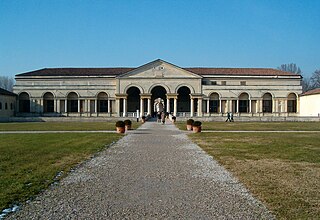
Palazzo del Te or Palazzo Te is a palace in the suburbs of Mantua, Italy. It is a fine example of the mannerist style of architecture, and the acknowledged masterpiece of Giulio Romano. Although formed in Italian, the usual name in English of Palazzo del Te is not that now used by Italians. The official modern name, and by far the most common name in Italian, is Palazzo Te. The English name arises because Vasari calls it the "Palazzo Del T", and English-speaking writers, especially art historians, still most often call it "Palazzo del Te".

Pellegrino Tibaldi, also known as Pellegrino di Tibaldo de Pellegrini, was an Italian mannerist architect, sculptor, and mural painter.

Girolamo Francesco Maria Mazzola, also known as Francesco Mazzola or, more commonly, as Parmigianino, was an Italian Mannerist painter and printmaker active in Florence, Rome, Bologna, and his native city of Parma. His work is characterized by a "refined sensuality" and often elongation of forms and includes Vision of Saint Jerome (1527) and the iconic if somewhat anomalous Madonna with the Long Neck (1534), and he remains the best known artist of the first generation whose whole careers fall into the Mannerist period.
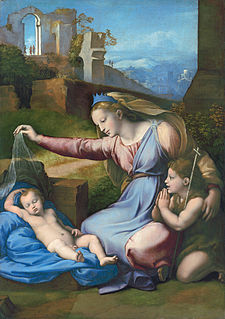
Gianfrancesco Penni (1488/1496–1528), also known as Giovan Francesco, was an Italian painter. His brother Bartolommeo was an artist of the Tudor court of Henry VIII, and another brother, Luca, ended up as one of the Italian artists of the School of Fontainebleau.
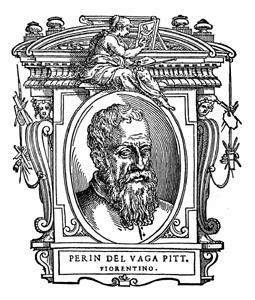
Perinodel Vaga was an Italian painter and draughtsman of the Late Renaissance/Mannerism.

Lorenzo Sabbatini or Sabatini, Sabattini or Sabadini, sometimes referred to as Lorenzino da Bologna, was an Italian painter of the Mannerist period from Bologna.
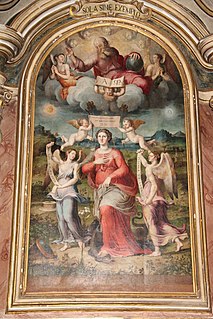
Raffaellino del Colle (1490–1566) was an Italian Mannerist painter active mostly in Umbria. He was born in the frazione of Colle in Borgo Sansepolcro, province of Arezzo, Tuscany, Italy.

The Palazzo Ducale di Mantova is a group of buildings in Mantua, Lombardy, northern Italy, built between the 14th and the 17th century mainly by the noble family of Gonzaga as their royal residence in the capital of their Duchy. The buildings are connected by corridors and galleries and are enriched by inner courts and wide gardens. The complex includes some 500 rooms and occupies an area of c. 34,000 m², which make it the sixth largest palace in Europe after the palaces of the Vatican, the Louvre Palace, the Palace of Versailles, the Royal Palace of Caserta and the Castle of Fontainebleau. It has more than 500 rooms and contains 7 gardens and 8 courtyards. Although most famous for Mantegna's frescos in the Camera degli Sposi, they have many other very significant architectural and painted elements.
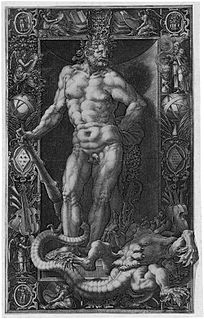
Giorgio Ghisi was an Italian engraver from Mantua who also worked in Antwerp and in France. He made both prints and damascened metalwork, although only two surviving examples of the latter are known.

Fermo Guisoni was an Italian painter of the Renaissance period, active mainly in his native city of Mantua.

Hendrick van den Broeck or Arrigo Fiammingo was a Flemish painter, fresco painter, glass painter and sculptor of the late-Renaissance or Mannerist period. After training in Flanders, he travelled to Italy where he remained active in various cities for the remainder of his life. He was court painter to Cosimo I de Medici in Florence and worked as a fresco painter in Rome on the large decorative projects of pope Gregory XIII.
Tommaso Barnabei, also known as Maso Papacello, was an Italian painter of the Renaissance.
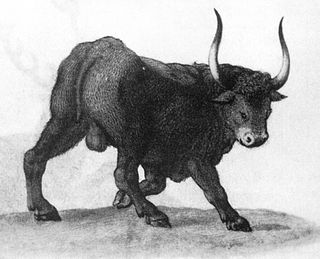
Teodoro Ghisi (1536–1601) was an Italian painter and engraver of the Renaissance Period, mainly active in his native Mantua. He specialized in paintings of animal and nature scenes.

The Church of Saints Martin and Sebastian of the Swiss is a Roman Catholic oratory in Vatican City. The church was built by Pope Pius V in 1568 to serve as a private chapel for the Pontifical Swiss Guards, whose barracks are located next to Porta San Pellegrino, close to the Apostolic Palace. It is considered the national church of Switzerland in Rome.
Camillo Capelli, also called Camillo Mantovano, was an Italian painter of the Renaissance period in northern Italy, including Pesaro and Venice.
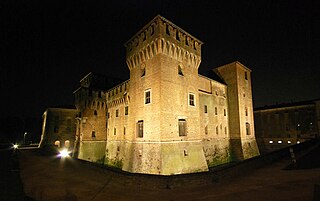
The Castello di San Giorgio is part of the Ducal palace of Mantua. It is a moated rectangular castle, each of which's four corners has a large tower and the moat is crossed by three drawbridges.

The Fall of the Giants is a fresco by the Italian Renaissance artist Giulio Romano. Born in Rome Giulio Romano was a pupil of Raphael. In the year 1522 he was courted by Federico II Gonzaga, the ruler of Mantua, who wanted him as his court artist as he was especially attracted by his skill as an architect. In the year 1524 Romano moved to Mantua where he remained for the rest of his life. According to Vasari, Baltasare Castilliogne was delegated by Federico II Gonzaga to procure Romano to execute paintings and architectureal procjects in the city of Mantua, Italy. His masterpiece of architecture and fresco painting in that city is the Palazzo del Te, with is famous illusionistic frescos. In one of rooms of palazzo, the Sala dei Giganti Giulio Romano had depicted the Gigantomachy,an episode derived from Greek mythology. The fresco was created between 1532 and 1534 and it was based on Ovid's Metamorphoses, a narrative poem consisting of 15 books that was written in Latin around 8 C.E. The episode of Gigantomachy depicts Jupiter defeating the Giants with his lighting. According to other versions of the myth, Jupiter resisted the Giants' assault thanks to the intervention of Pan or of the asses of Silenus and Bacchus. Nevertheless, in the 16th century in Italy it was uncommon to hear Latin. Texts were changed in structure and substance when transferred to Vulgate, so it should be understood that Giulio Romano had used the vernacular translation of the Metamorphoses for his Gigantomachy in the Palazzo del Te. The subject was very popular in the fine arts of the Cinquecento, once for sure because of its inherent possibilities for effective aesthetic design, on the other hand because this myth was important for the self-image of a patron of that time expressing religious, moral, political ideas.


















